2014 MERCEDES-BENZ CLS SHOOTING BRAKE air condition
[x] Cancel search: air conditionPage 7 of 417
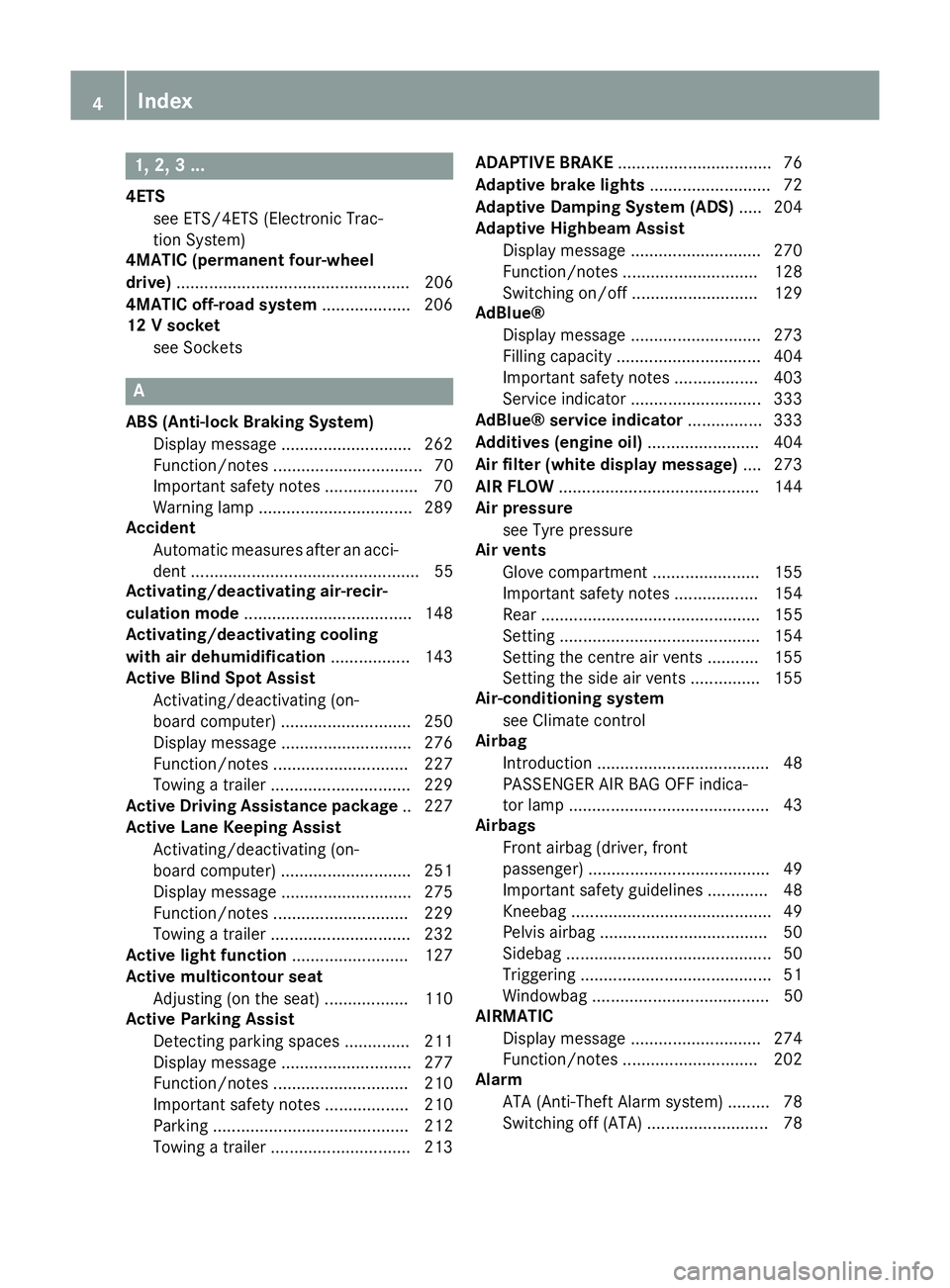
1, 2, 3 ...
4ETS see ETS/4ETS (Electronic Trac-
tion System)
4MATIC (permanent four-wheel
drive) .................................................. 206
4MATIC off-road system ...................206
12 V socket
see Sockets A
ABS (Anti-lock Braking System) Display message ............................ 262
Function/notes ................................ 70
Important safety notes .................... 70
Warning lamp ................................. 289
Accident
Automatic measures after an acci-
dent ................................................. 55
Activating/deactivating air-recir-
culation mode ................................... .148
Activating/deactivating cooling
with air dehumidification ................. 143
Active Blind Spot Assist
Activating/deactivating (on-
board computer) ............................ 250
Display message ............................ 276
Function/notes ............................ .227
Towing a trailer .............................. 229
Active Driving Assistance package .. 227
Active Lane Keeping Assist
Activating/deactivating (on-
board computer) ............................ 251
Display message ............................ 275
Function/notes ............................ .229
Towing a trailer .............................. 232
Active light function ......................... 127
Active multicontour seat
Adjusting (on the seat) .................. 110
Active Parking Assist
Detecting parking spaces .............. 211
Display message ............................ 277
Function/notes ............................ .210
Important safety notes .................. 210
Parking .......................................... 212
Towing a trailer .............................. 213 ADAPTIVE BRAKE
................................. 76
Adaptive brake lights .......................... 72
Adaptive Damping System (ADS) ..... 204
Adaptive Highbeam Assist
Display message ............................ 270
Function/notes ............................ .128
Switching on/off ........................... 129
AdBlue®
Display message ............................ 273
Filling capacity ............................... 404
Important safety notes .................. 403
Service indicator ............................ 333
AdBlue® service indicator ................ 333
Additives (engine oil) ........................ 404
Air filter (white display message) .... 273
AIR FLOW .......................................... .144
Air pressure
see Tyre pressure
Air vents
Glove compartment ....................... 155
Important safety notes .................. 154
Rear ............................................... 155
Setting .......................................... .154
Setting the centre air vents ........... 155
Setting the side air vents .............. .155
Air-conditioning system
see Climate control
Airbag
Introduction ..................................... 48
PASSENGER AIR BAG OFF indica-
tor lamp .......................................... .43
Airbags
Front airbag (driver, front
passenger) ...................................... .49
Important safety guidelines .............48
Kneebag ........................................... 49
Pelvis airbag .................................... 50
Sidebag ............................................ 50
Triggering .........................................51
Windowbag ...................................... 50
AIRMATIC
Display message ............................2 74
Function/notes ............................ .202
Alarm
ATA (Anti-Theft Alarm system) ......... 78
Switching off (ATA) .......................... 78 4
Index
Page 11 of 417
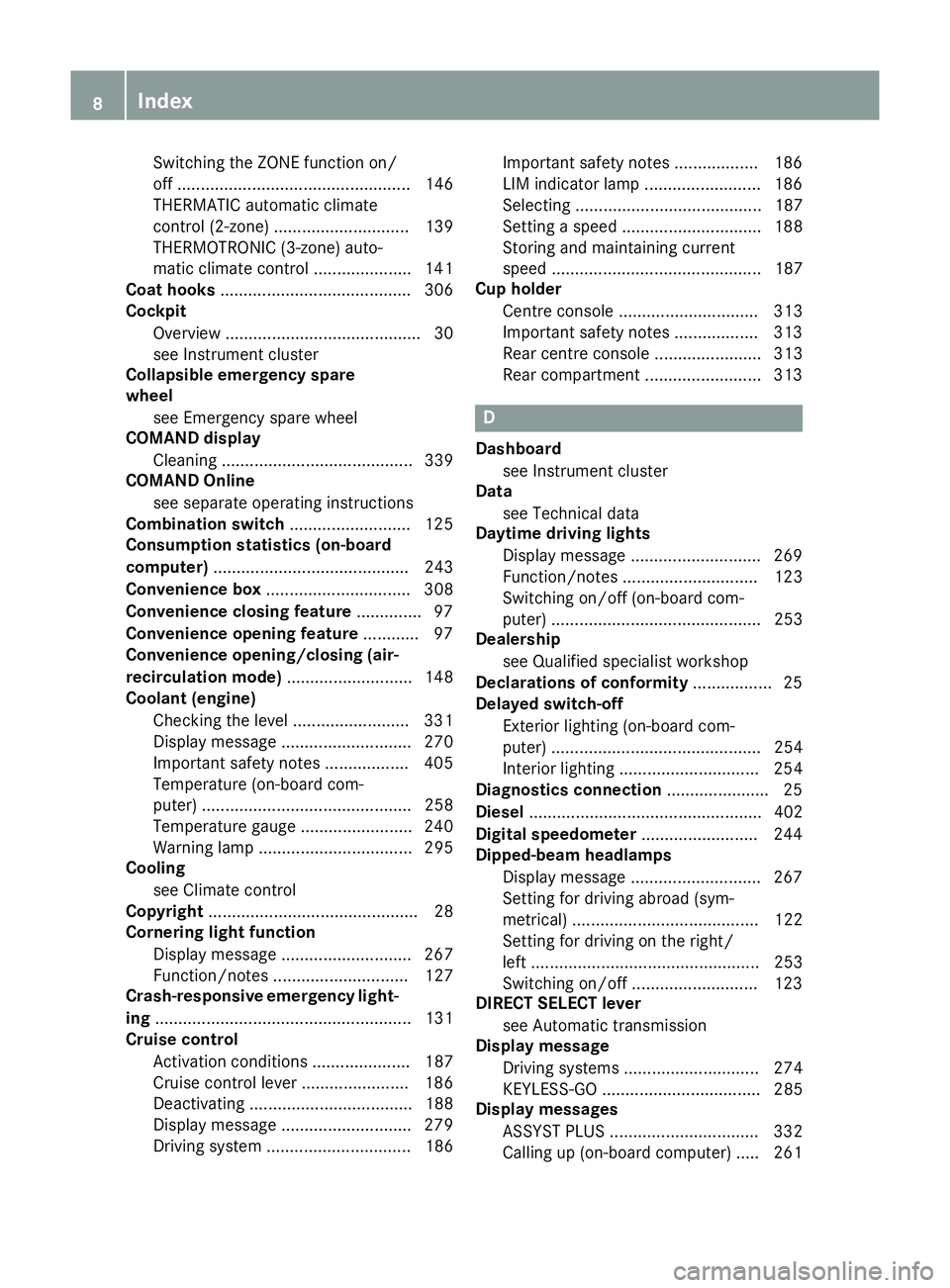
Switching the ZONE function on/
off .................................................. 146
THERMATIC automatic climate
control (2-zone) ............................. 139
THERMOTRONIC (3-zone) auto-
matic climate control ..................... 141
Coat hooks ......................................... 306
Cockpit
Overview .......................................... 30
see Instrument cluster
Collapsible emergency spare
wheel
see Emergency spare wheel
COMAND display
Cleaning ......................................... 339
COMAND Online
see separate operating instructions
Combination switch .......................... 125
Consumption statistics (on-board
computer) .......................................... 243
Convenience box ............................... 308
Convenience closing feature .............. 97
Convenience opening feature ............ 97
Convenience opening/closing (air-
recirculation mode) ........................... 148
Coolant (engine)
Checking the level ......................... 331
Display message ............................ 270
Important safety notes .................. 405
Temperature (on-board com-
puter) ............................................. 258
Temperature gaug e........................ 240
Warning lamp ................................. 295
Cooling
see Climate control
Copyright ............................................. 28
Cornering light function
Display message ............................ 267
Function/note s............................. 127
Crash-responsive emergency light-
ing ....................................................... 131
Cruise control
Activation conditions ..................... 187
Cruise control lever ....................... 186
Deactivating ................................... 188
Display message ............................ 279
Driving system ............................... 186 Important safety notes .................. 186
LIM indicator lamp ......................... 186
Selecting ........................................ 187
Setting a speed .............................. 188
Storing and maintaining current
speed ............................................. 187
Cup holder
Centre console .............................. 313
Important safety notes .................. 313
Rear centre console ....................... 313
Rear compartment ......................... 313 D
Dashboard see Instrument cluster
Data
see Technical data
Daytime driving lights
Display message ............................ 269
Function/note s............................. 123
Switching on/off (on-board com-
puter) ............................................. 253
Dealership
see Qualified specialist workshop
Declarations of conformity ................. 25
Delayed switch-off
Exterior lighting (on-board com-
puter) ............................................. 254
Interior lighting .............................. 254
Diagnostics connection ...................... 25
Diesel .................................................. 402
Digital speedometer ......................... 244
Dipped-beam headlamps
Display message ............................ 267
Setting for driving abroad (sym-
metrical) ........................................ 122
Setting for driving on the right/
left ................................................. 253
Switching on/of f........................... 123
DIRECT SELECT lever
see Automatic transmission
Display message
Driving system s............................. 274
KEYLESS-GO .................................. 285
Display messages
ASSYST PLU S................................ 332
Calling up (on-board computer) ..... 261 8
Index
Page 12 of 417
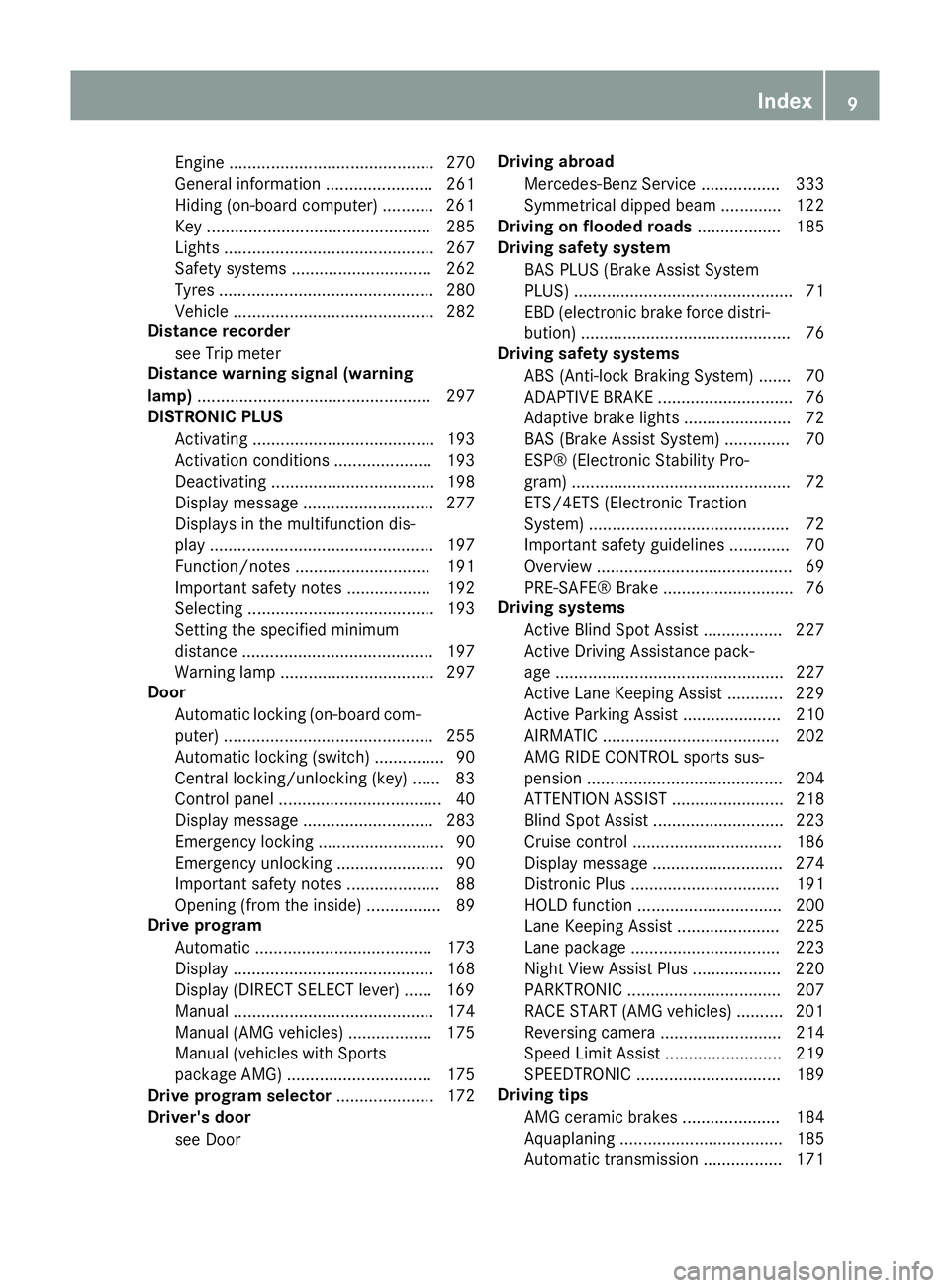
Engine ............................................ 270
General information ....................... 261
Hiding (on-board computer) ........... 261
Key ................................................ 285
Lights ............................................. 267
Safety systems .............................. 262
Tyres .............................................. 280
Vehicle ........................................... 282
Distance recorder
see Trip meter
Distance warning signal (warning
lamp) .................................................. 297
DISTRONIC PLUS
Activating ....................................... 193
Activation conditions ..................... 193
Deactivating ................................... 198
Display message ............................ 277
Displays in the multifunction dis-
play ................................................ 197
Function/note s............................. 191
Important safety notes .................. 192
Selecting ........................................ 193
Setting the specified minimum
distance ......................................... 197
Warning lamp ................................. 297
Door
Automatic locking (on-board com-
puter) ............................................. 255
Automatic locking (switch) ............... 90
Central locking/unlocking (key) ...... 83
Control panel ................................... 40
Display message ............................ 283
Emergency locking ........................... 90
Emergency unlocking ....................... 90
Important safety notes .................... 88
Opening (from the inside) ................ 89
Drive program
Automatic ...................................... 173
Display ........................................... 168
Display (DIRECT SELECT lever) ...... 169
Manual ........................................... 174
Manual (AMG vehicles) .................. 175
Manual (vehicles with Sports
package AMG) ............................... 175
Drive program selector ..................... 172
Driver's door
see Door Driving abroad
Mercedes-Benz Service ................. 333
Symmetrical dipped beam ............. 122
Driving on flooded roads .................. 185
Driving safety system
BAS PLUS (Brake Assist System
PLUS) ............................................... 71
EBD (electronic brake force distri-bution) ............................................. 76
Driving safety systems
ABS (Anti-lock Braking System) ....... 70
ADAPTIVE BRAK E............................. 76
Adaptive brake lights ....................... 72
BAS (Brake Assist System) .............. 70
ESP® (Electronic Stability Pro-
gram) ............................................... 72
ETS/4ETS (Electronic Traction
System) ........................................... 72
Important safety guidelines ............. 70
Overview .......................................... 69
PRE-SAFE® Brake ............................ 76
Driving systems
Active Blind Spot Assist ................. 227
Active Driving Assistance pack-
age ................................................. 227
Active Lane Keeping Assist ............ 229
Active Parking Assist ..................... 210
AIRMATIC ...................................... 202
AMG RIDE CONTROL sports sus-
pension .......................................... 204
ATTENTION ASSIST ........................ 218
Blind Spot Assist ............................ 223
Cruise control ................................ 186
Display message ............................ 274
Distronic Plus ................................ 191
HOLD function ............................... 200
Lane Keeping Assist ...................... 225
Lane package ................................ 223
Night View Assist Plus ................... 220
PARKTRONIC ................................. 207
RACE START (AMG vehicles) .......... 201
Reversing camera .......................... 214
Speed Limit Assist ......................... 219
SPEEDTRONIC ............................... 189
Driving tips
AMG ceramic brakes ..................... 184
Aquaplaning ................................... 185
Automatic transmission ................. 171 Index
9
Page 26 of 417
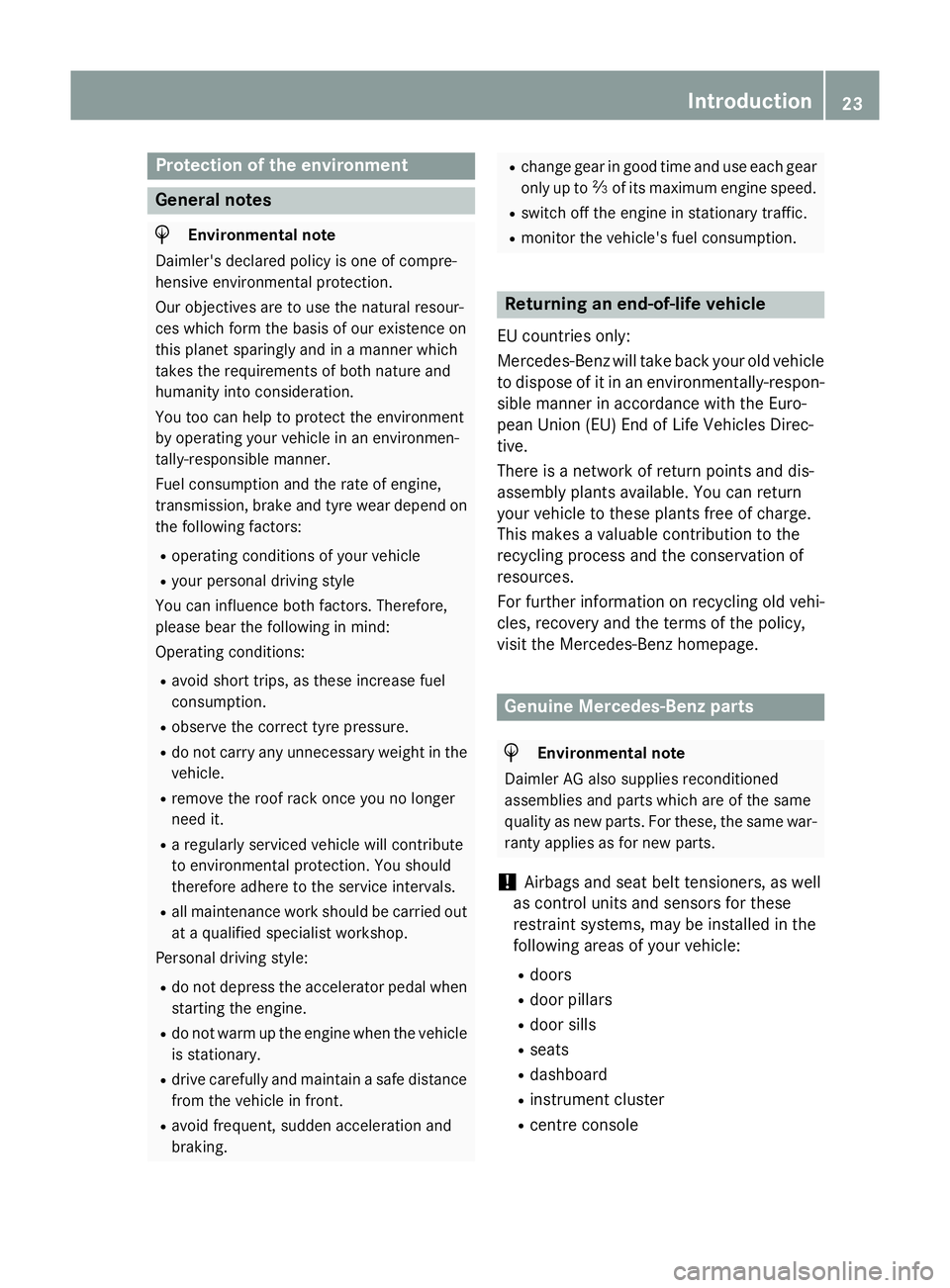
Protection of the environment
General notes
H
Environmental note
Daimler's declared policy is one of compre-
hensive environmental protection.
Our objectives are to use the natural resour-
ces which form the basis of our existence on
this planet sparingly and in a manner which
takes the requirements of both nature and
humanity into consideration.
You too can help to protect the environment
by operating your vehicle in an environmen-
tally-responsible manner.
Fuel consumption and the rate of engine,
transmission, brake and tyre wear depend on
the following factors:
R operating conditions of your vehicle
R your personal driving style
You can influence both factors. Therefore,
please bear the following in mind:
Operating conditions:
R avoid short trips, as these increase fuel
consumption.
R observe the correct tyre pressure.
R do not carry any unnecessary weight in the
vehicle.
R remove the roof rack once you no longer
need it.
R a regularly serviced vehicle will contribute
to environmental protection. You should
therefore adhere to the service intervals.
R all maintenance work should be carried out
at a qualified specialist workshop.
Personal driving style:
R do not depress the accelerator pedal when
starting the engine.
R do not warm up the engine when the vehicle
is stationary.
R drive carefully and maintain a safe distance
from the vehicle in front.
R avoid frequent, sudden acceleration and
braking. R
change gear in good time and use each gear
only up to Ôof its maximum engine speed.
R switch off the engine in stationary traffic.
R monitor the vehicle's fuel consumption. Returning an end-of-life vehicle
EU countries only:
Mercedes-Benz will take back your old vehicle to dispose of it in an environmentally-respon-sible manner in accordance with the Euro-
pean Union (EU) End of Life Vehicles Direc-
tive.
There is a network of return points and dis-
assembly plants available. You can return
your vehicle to these plants free of charge.
This makes a valuable contribution to the
recycling process and the conservation of
resources.
For further information on recycling old vehi- cles, recovery and the terms of the policy,
visit the Mercedes-Benz homepage. Genuine Mercedes-Benz parts
H
Environmental note
Daimler AG also supplies reconditioned
assemblies and parts which are of the same
quality as new parts. For these, the same war-
ranty applies as for new parts.
! Airbags and seat belt tensioners, as well
as control units and sensors for these
restraint systems, may be installed in the
following areas of your vehicle:
R doors
R door pillars
R door sills
R seats
R dashboard
R instrument cluster
R centre console Introduction
23 Z
Page 28 of 417
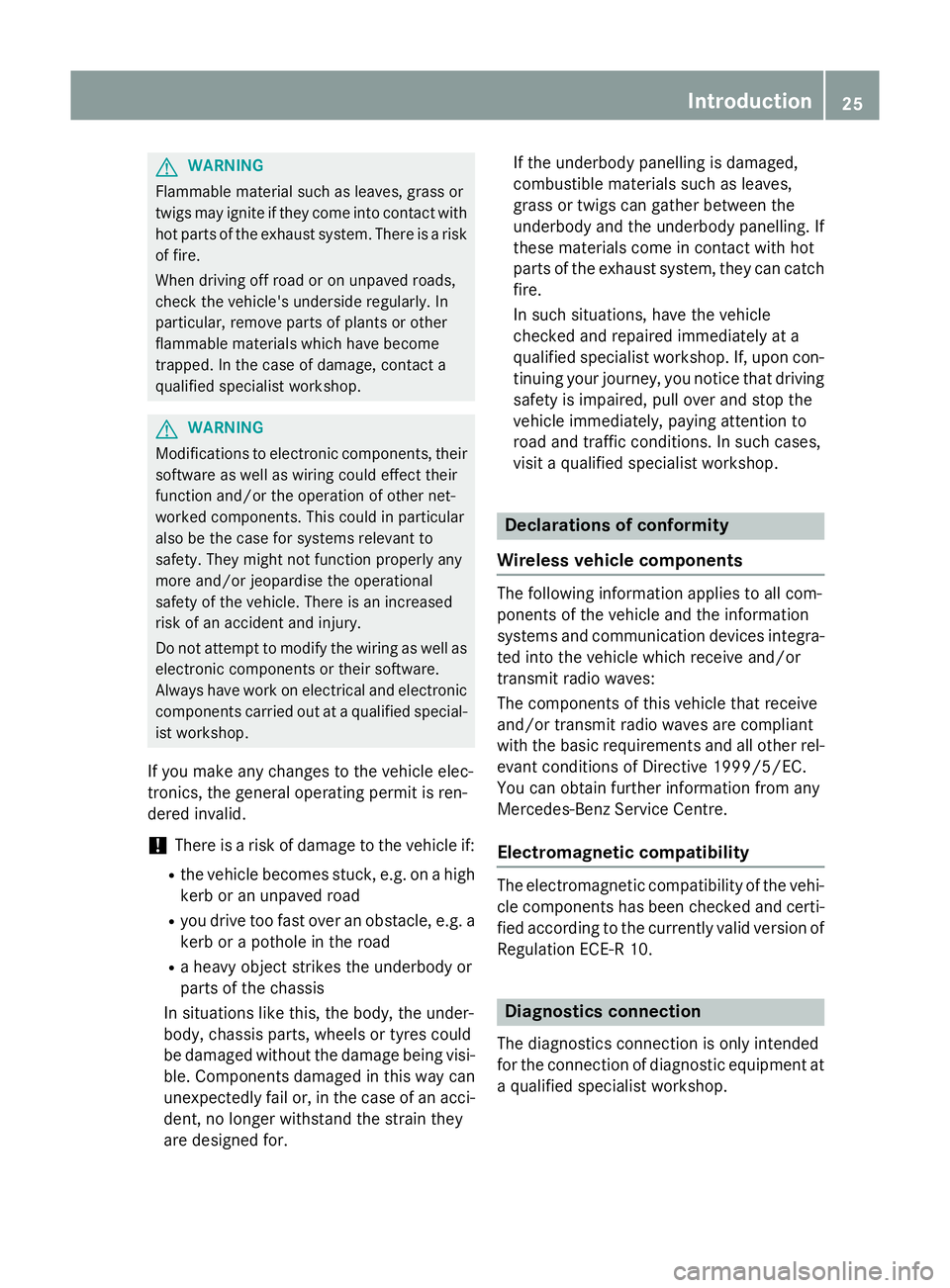
G
WARNING
Flammable material such as leaves, grass or
twigs may ignite if they come into contact with hot parts of the exhaust system. There is a risk of fire.
When driving off road or on unpaved roads,
check the vehicle's underside regularly. In
particular, remove parts of plants or other
flammable materials which have become
trapped. In the case of damage, contact a
qualified specialist workshop. G
WARNING
Modifications to electronic components, their software as well as wiring could effect their
function and/or the operation of other net-
worked components. This could in particular
also be the case for systems relevant to
safety. They might not function properly any
more and/or jeopardise the operational
safety of the vehicle. There is an increased
risk of an accident and injury.
Do not attempt to modify the wiring as well as
electronic components or their software.
Always have work on electrical and electronic components carried out at a qualified special-
ist workshop.
If you make any changes to the vehicle elec-
tronics, the general operating permit is ren-
dered invalid.
! There is a risk of damage to the vehicle if:
R the vehicle becomes stuck, e.g. on a high
kerb or an unpaved road
R you drive too fast over an obstacle, e.g. a
kerb or a pothole in the road
R a heavy object strikes the underbody or
parts of the chassis
In situations like this, the body, the under-
body, chassis parts, wheels or tyres could
be damaged without the damage being visi-
ble. Components damaged in this way can
unexpectedly fail or, in the case of an acci-
dent, no longer withstand the strain they
are designed for. If the underbody panelling is damaged,
combustible materials such as leaves,
grass or twigs can gather between the
underbody and the underbody panelling. If
these materials come in contact with hot
parts of the exhaust system, they can catch
fire.
In such situations, have the vehicle
checked and repaired immediately at a
qualified specialist workshop. If, upon con-
tinuing your journey, you notice that driving
safety is impaired, pull over and stop the
vehicle immediately, paying attention to
road and traffic conditions. In such cases,
visit a qualified specialist workshop. Declarations of conformity
Wireless vehicle components The following information applies to all com-
ponents of the vehicle and the information
systems and communication devices integra-
ted into the vehicle which receive and/or
transmit radio waves:
The components of this vehicle that receive
and/or transmit radio waves are compliant
with the basic requirements and all other rel-
evant conditions of Directive 1999/5/EC.
You can obtain further information from any
Mercedes-Benz Service Centre.
Electromagnetic compatibility The electromagnetic compatibility of the vehi-
cle components has been checked and certi- fied according to the currently valid version of Regulation ECE-R 10. Diagnostics connection
The diagnostics connection is only intended
for the connection of diagnostic equipment at a qualified specialist workshop. Introduction
25 Z
Page 30 of 417
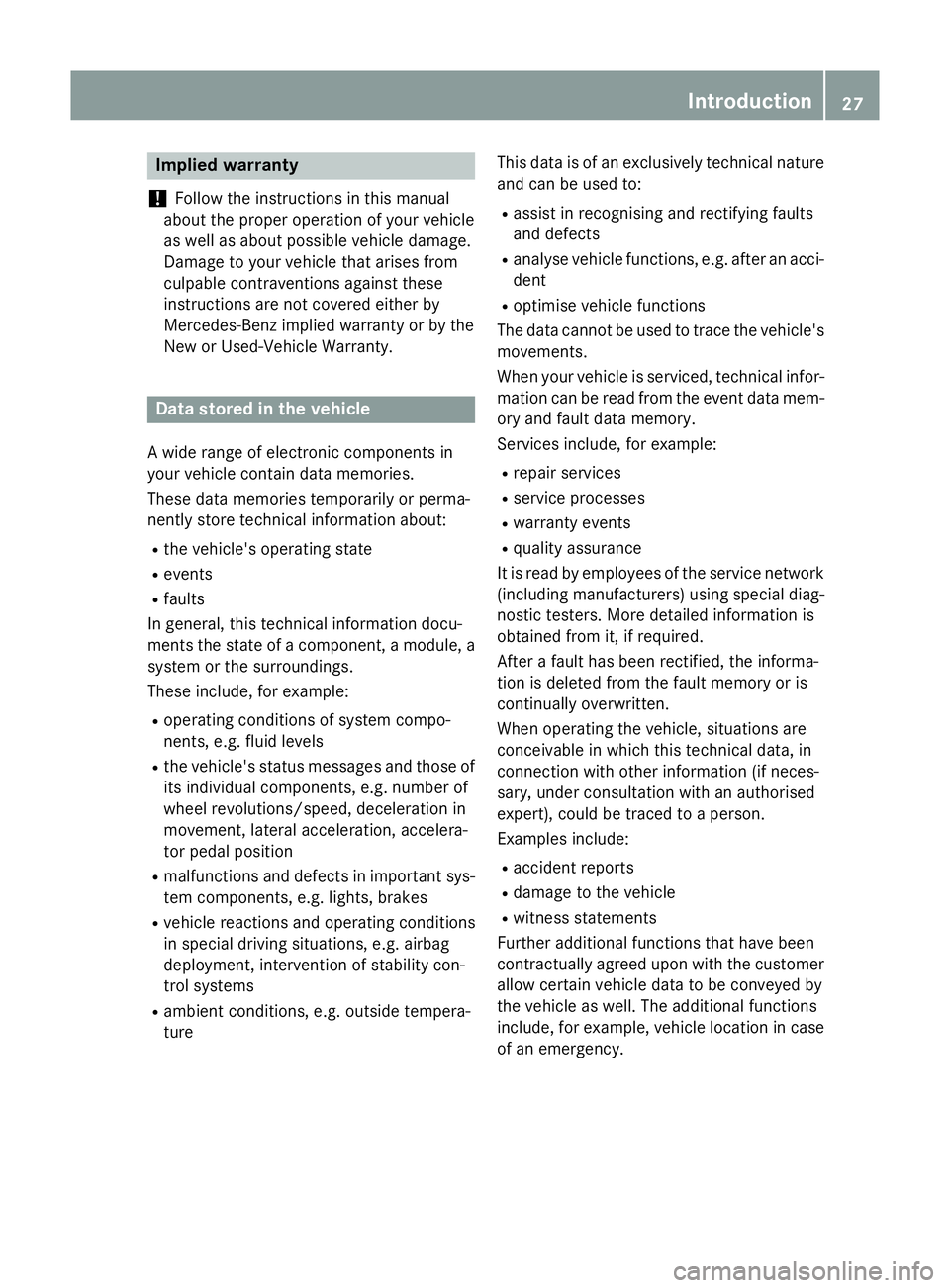
Implied warranty
! Follow the instructions in this manual
about the proper operation of your vehicle
as well as about possible vehicle damage.
Damage to your vehicle that arises from
culpable contraventions against these
instructions are not covered either by
Mercedes-Benz implied warranty or by the
New or Used-Vehicle Warranty. Data stored in the vehicle
A wide range of electronic components in
your vehicle contain data memories.
These data memories temporarily or perma-
nently store technical information about:
R the vehicle's operating state
R events
R faults
In general, this technical information docu-
ments the state of a component, a module, a
system or the surroundings.
These include, for example:
R operating conditions of system compo-
nents, e.g. fluid levels
R the vehicle's status messages and those of
its individual components, e.g. number of
wheel revolutions/speed, deceleration in
movement, lateral acceleration, accelera-
tor pedal position
R malfunctions and defects in important sys-
tem components, e.g. lights, brakes
R vehicle reactions and operating conditions
in special driving situations, e.g. airbag
deployment, intervention of stability con-
trol systems
R ambient conditions, e.g. outside tempera-
ture This data is of an exclusively technical nature
and can be used to:
R assist in recognising and rectifying faults
and defects
R analyse vehicle functions, e.g. after an acci-
dent
R optimise vehicle functions
The data cannot be used to trace the vehicle's movements.
When your vehicle is serviced, technical infor-
mation can be read from the event data mem- ory and fault data memory.
Services include, for example:
R repair services
R service processes
R warranty events
R quality assurance
It is read by employees of the service network (including manufacturers) using special diag-
nostic testers. More detailed information is
obtained from it, if required.
After a fault has been rectified, the informa-
tion is deleted from the fault memory or is
continually overwritten.
When operating the vehicle, situations are
conceivable in which this technical data, in
connection with other information (if neces-
sary, under consultation with an authorised
expert), could be traced to a person.
Examples include:
R accident reports
R damage to the vehicle
R witness statements
Further additional functions that have been
contractually agreed upon with the customer
allow certain vehicle data to be conveyed by
the vehicle as well. The additional functions
include, for example, vehicle location in case of an emergency. Introduction
27 Z
Page 55 of 417
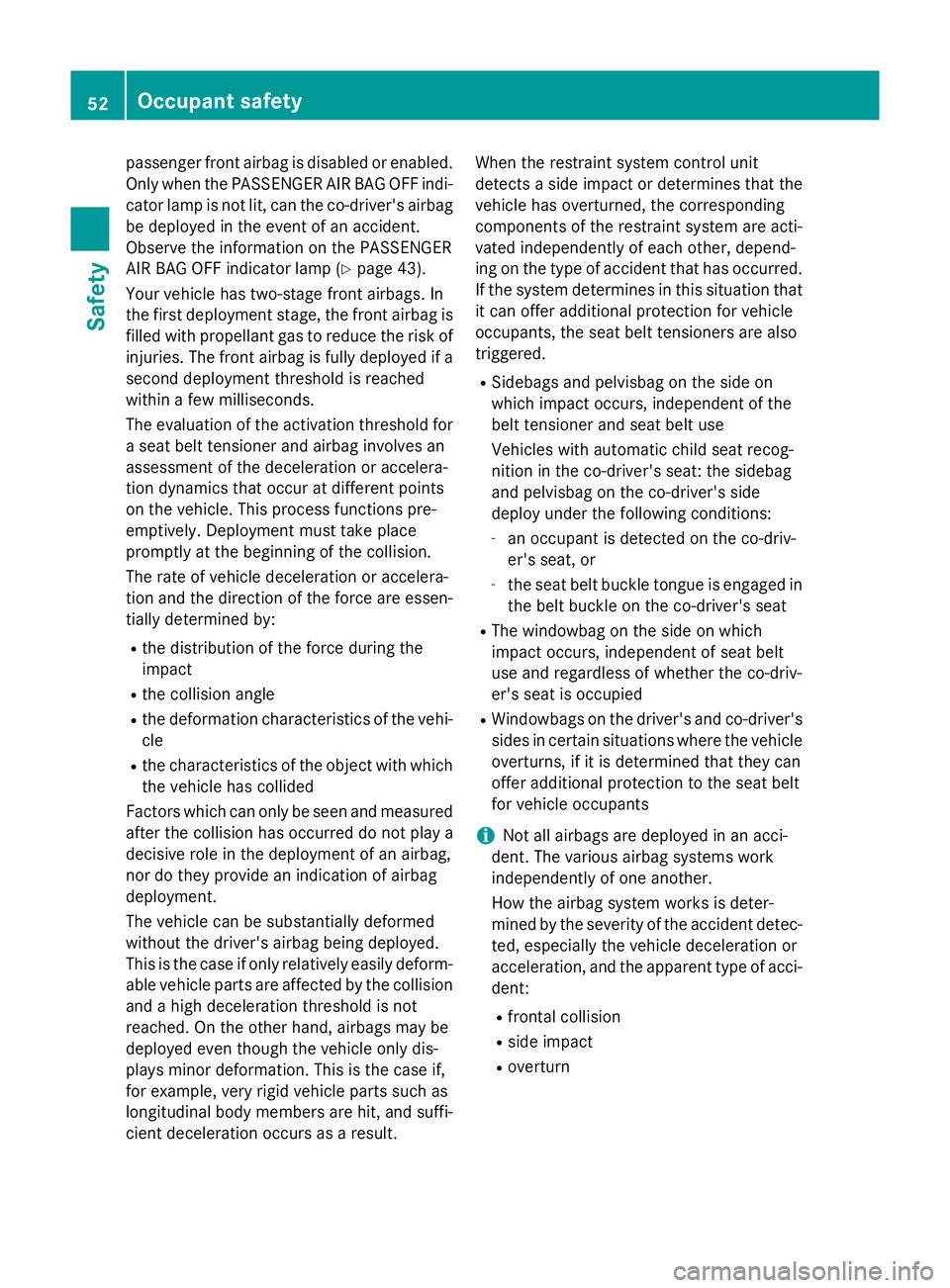
passenger front airbag is disabled or enabled.
Only when the PASSENGER AIR BAG OFF indi-cator lamp is not lit, can the co-driver's airbag
be deployed in the event of an accident.
Observe the information on the PASSENGER
AIR BAG OFF indicator lamp (Y page 43).
Your vehicle has two-stage front airbags. In
the first deployment stage, the front airbag is filled with propellant gas to reduce the risk of
injuries. The front airbag is fully deployed if a second deployment threshold is reached
within a few milliseconds.
The evaluation of the activation threshold for
a seat belt tensioner and airbag involves an
assessment of the deceleration or accelera-
tion dynamics that occur at different points
on the vehicle. This process functions pre-
emptively. Deployment must take place
promptly at the beginning of the collision.
The rate of vehicle deceleration or accelera-
tion and the direction of the force are essen- tially determined by:
R the distribution of the force during the
impact
R the collision angle
R the deformation characteristics of the vehi-
cle
R the characteristics of the object with which
the vehicle has collided
Factors which can only be seen and measured after the collision has occurred do not play a
decisive role in the deployment of an airbag,
nor do they provide an indication of airbag
deployment.
The vehicle can be substantially deformed
without the driver's airbag being deployed.
This is the case if only relatively easily deform-
able vehicle parts are affected by the collision
and a high deceleration threshold is not
reached. On the other hand, airbags may be
deployed even though the vehicle only dis-
plays minor deformation. This is the case if,
for example, very rigid vehicle parts such as
longitudinal body members are hit, and suffi-
cient deceleration occurs as a result. When the restraint system control unit
detects a side impact or determines that the
vehicle has overturned, the corresponding
components of the restraint system are acti-
vated independently of each other, depend-
ing on the type of accident that has occurred.
If the system determines in this situation that
it can offer additional protection for vehicle
occupants, the seat belt tensioners are also
triggered.
R Sidebags and pelvisbag on the side on
which impact occurs, independent of the
belt tensioner and seat belt use
Vehicles with automatic child seat recog-
nition in the co-driver's seat: the sidebag
and pelvisbag on the co-driver's side
deploy under the following conditions:
- an occupant is detected on the co-driv-
er's seat, or
- the seat belt buckle tongue is engaged in
the belt buckle on the co-driver's seat
R The windowbag on the side on which
impact occurs, independent of seat belt
use and regardless of whether the co-driv-
er's seat is occupied
R Windowbags on the driver's and co-driver's
sides in certain situations where the vehicle
overturns, if it is determined that they can
offer additional protection to the seat belt
for vehicle occupants
i Not all airbags are deployed in an acci-
dent. The various airbag systems work
independently of one another.
How the airbag system works is deter-
mined by the severity of the accident detec- ted, especially the vehicle deceleration or
acceleration, and the apparent type of acci- dent:
R frontal collision
R side impact
R overturn 52
Occupant safetySafety
Page 73 of 417
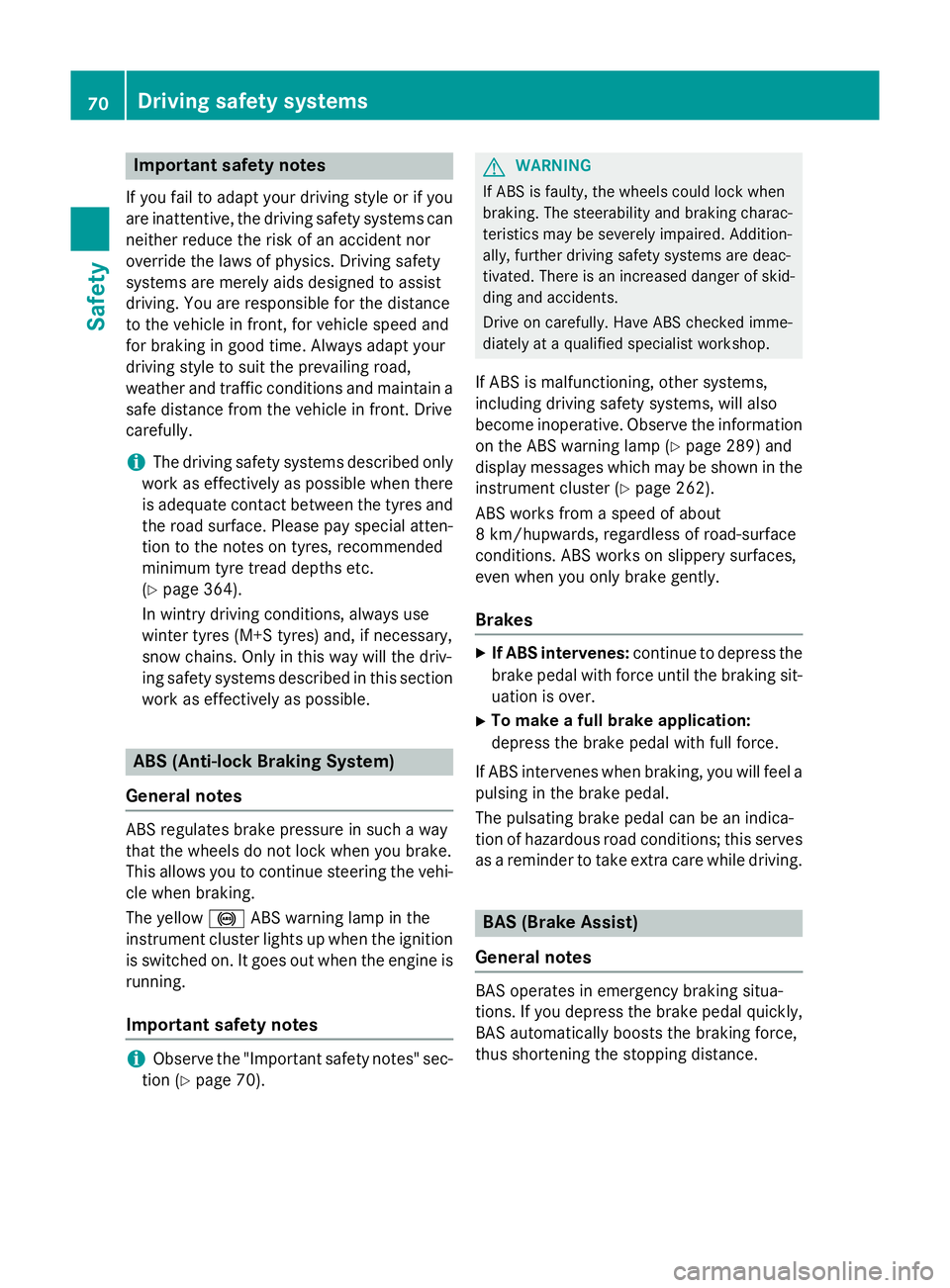
Important safety notes
If you fail to adapt your driving style or if you
are inattentive, the driving safety systems can
neither reduce the risk of an accident nor
override the laws of physics. Driving safety
systems are merely aids designed to assist
driving. You are responsible for the distance
to the vehicle in front, for vehicle speed and
for braking in good time. Always adapt your
driving style to suit the prevailing road,
weather and traffic conditions and maintain a
safe distance from the vehicle in front. Drive
carefully.
i The driving safety systems described only
work as effectively as possible when there
is adequate contact between the tyres and the road surface. Please pay special atten-
tion to the notes on tyres, recommended
minimum tyre tread depths etc.
(Y page 364).
In wintry driving conditions, always use
winter tyres (M+S tyres) and, if necessary,
snow chains. Only in this way will the driv-
ing safety systems described in this section work as effectively as possible. ABS (Anti-lock Braking System)
General notes ABS regulates brake pressure in such a way
that the wheels do not lock when you brake.
This allows you to continue steering the vehi- cle when braking.
The yellow !ABS warning lamp in the
instrument cluster lights up when the ignition
is switched on. It goes out when the engine is running.
Important safety notes i
Observe the "Important safety notes" sec-
tion (Y page 70). G
WARNING
If ABS is faulty, the wheels could lock when
braking. The steerability and braking charac-
teristics may be severely impaired. Addition-
ally, further driving safety systems are deac-
tivated. There is an increased danger of skid- ding and accidents.
Drive on carefully. Have ABS checked imme-
diately at a qualified specialist workshop.
If ABS is malfunctioning, other systems,
including driving safety systems, will also
become inoperative. Observe the information on the ABS warning lamp (Y page 289) and
display messages which may be shown in the
instrument cluster (Y page 262).
ABS works from a speed of about
8 km/hupwards, regardless of road-surface
conditions. ABS works on slippery surfaces,
even when you only brake gently.
Brakes X
If ABS intervenes: continue to depress the
brake pedal with force until the braking sit- uation is over.
X To make a full brake application:
depress the brake pedal with full force.
If ABS intervenes when braking, you will feel a
pulsing in the brake pedal.
The pulsating brake pedal can be an indica-
tion of hazardous road conditions; this serves as a reminder to take extra care while driving. BAS (Brake Assist)
General notes BAS operates in emergency braking situa-
tions. If you depress the brake pedal quickly,
BAS automatically boosts the braking force,
thus shortening the stopping distance. 70
Driving safety systemsSafety